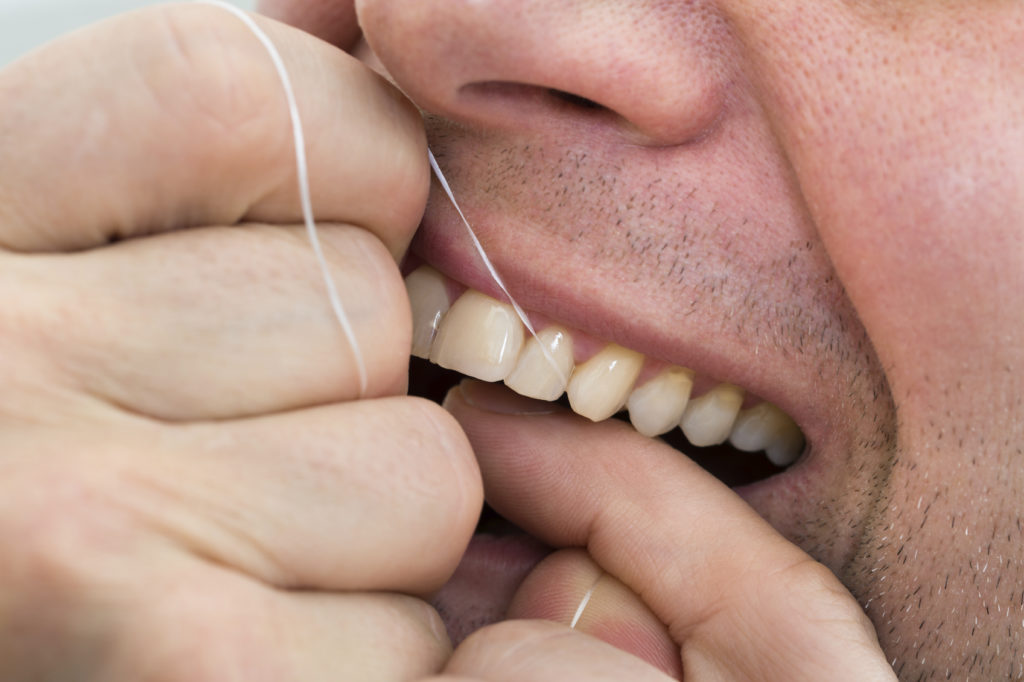Flossing is an important step in your daily oral care routine, because floss is able to reach the places toothbrushes simply can’t. When food is left between the teeth after brushing, bacteria can still grow and with enough time cause tooth decay. Flossing isn’t only important for your teeth’s health, but your gum health as well. The bacteria that cause tooth decay also can cause gum disease if left unchecked. This is why flossing is so important.
What Is a Water Flosser?
We’re all familiar with traditional floss, but may be less familiar with water flossers. Water flossers are devices that utilize the power and fluidity of water to get to hard to reach areas inside the mouth. It is typically a three part system consisting of a water receptacle, a pump, and a nozzle to aim the water. You may have seen a water flosser at one of your teeth cleanings and may be thinking, “How am I supposed to fit that big thing in my bathroom,” but don’t worry. With advancements in technology, water flossers can be implemented in the home without taking up too much space.
Advantages of a Water Flosser
Compared to regular dental floss, water flossers boast some great benefits. First, a water flosser can save you money in the long run. If you’re an avid flosser, you know how much dental floss you can go through. The cost adds up over time, but with a water flosser your purchase is one time, meaning you save money in the future. Second, water flossers can make it easier to get to the back of the mouth compared to traditional floss. Because the nozzle of a water flosser is meant to be able to reach all of your mouth, you won’t need to fuss over flossing your back molars any more. Third, water flossers can be gentler on your gums. Traditional floss can damage your gums if used improperly, but with the gentle stream of a water flosser, cutting your gums really isn’t possible.
Advantages of Traditional Floss
While the advantages of water flossers seem to be great, traditional floss may be a better route for some people. The first advantage of traditional floss is the short term cost. Floss is very cheap compared to some of the more expensive water flossers on the market, and if you’re on a budget that price tag can be a little daunting. Second, traditional floss takes less time to get used to. When using a water flosser, you must practice your technique before being able to properly floss, and some people may not want to learn how to floss all over again. Lastly, traditional floss cleans in-between your teeth the same amount as a water flosser.
No method of flossing is better as long as you do it correctly, so the water flosser doesn’t offer any superior cleaning benefit to traditional floss. If you have more questions about flossing, give us a call at 479-646-0706.
Best Natural Sources of Fluoride
For Americans, the most common source of fluoride that we take in every day is in our tap water and toothpaste. The fluoride in these things can help strengthen our teeth by bonding itself to the tooth and bolstering the strength of our enamel. Fluoride has proven beneficial for reducing cavities in children and adults alike. You may think of fluoride as a chemical that can only be found in the dentist office or in tap water, but actually, fluoride is a naturally occurring chemical that can be found in all kinds of foods and drinks.
Fruits Packed with Fluoride
One source of naturally occurring fluoride can be found in apples. Yes, that’s right! The food that can keep all the doctors away can also strengthen your teeth and create a healthier smile. Apples have about .03 parts per million of fluoride in them. If you’re looking for a fruit that packs more of a fluoride punch, however, look no further than avocados. Avocados are known for having a lot of healthy fats in them, but they also contain up to .07 parts per million of fluoride. In comparison, this is more fluoride than the water found in natural water sources. One final fruit to consider when talking fluoride is the humble strawberry. Strawberries contain more fluoride than apples and make for an easy on the go snack when in a rush.
Powerful Veggies
Like fruits, veggies can contain a lot of naturally occurring fluoride. Our top picks for powerful veggies are carrots, lettuce, and radishes. You can’t have a salad without lettuce, and that’s good for your teeth because lettuce contains .05 parts per million of fluoride. Carrots can contain up to .03 parts per million of fluoride which makes them a great addition to your salad and can even be grinded up and added to a tomato sauce to add extra sweetness. To spice up your salad, we recommend tossing in some fresh radishes which can contain a whopping .06 parts per million of the good stuff.
Other Foods Containing Fluoride
By now, you probably understand why your doctor is always telling you to eat healthy, but there are some other foods that aren’t fruits and veggies which can help your teeth. If you’re a seafood lover, you’re in luck! Crab, shrimp, and some fish like sardines can have lots of fluoride.
The Bottom Line
Though there are many foods with naturally occurring fluoride, it is important to note that no food can replace proper dental hygiene. This is why we always recommend not only brushing and flossing at least twice a day, but also making regular visits once every six months to our office. Give us a call at 479-646-0706 and we can schedule you an appointment today. Maybe we can even talk about other nutritious foods with high fluoride!

